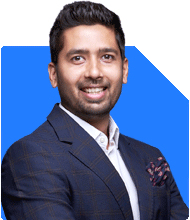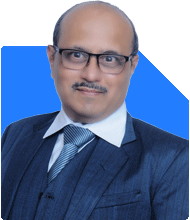Ramalingam Kalirajan |9712 Answers |Ask -Follow
Mutual Funds, Financial Planning Expert - Answered on Jun 20, 2025
He has an MBA in finance from the University of Madras and is a certified financial planner.
He is the director and chief financial planner at Holistic Investment, a Chennai-based firm that offers financial planning and wealth management advice.... more

Hello expert, I received 88 lakh from multiple insurance policies that matured unexpectedly over the last year. I don't have an urgent need for this money. I already invest 25,000 per month in mutual funds. I am earning 75,000 per month with home loan EMI of 18,000. I am 42, married and want to use this money to build long-term wealth and maybe retire by 55. What's the best way to use this lump sum without risking too much?
You already have a solid base with mutual funds and manageable EMI.
Now let us create a step-by-step strategy for long-term wealth building.
You are 42, and your goal is to retire by 55.
This gives you a 13-year window to grow your money wisely.
Let’s now look at a 360-degree plan that matches your profile and risk comfort.
Understanding Your Present Financial Position
Age: 42
Monthly income: Rs. 75,000
Existing SIP: Rs. 25,000 in mutual funds
Home loan EMI: Rs. 18,000
Emergency need: None right now
Lump sum available: Rs. 88 lakh
Marital status: Married
Retirement goal: Age 55
Initial Observations:
Saving over 30% of your income is a healthy practice.
Home loan EMI is affordable compared to income.
Existing mutual fund SIP is a great start.
Lump sum can now give a boost to your retirement planning.
Step 1: Emergency Fund – Keep a Safety Buffer
You may not have mentioned emergency funds.
Still, it is very important to set it aside first.
Recommendations:
Set aside Rs. 3 to 6 lakh in fixed deposits or liquid mutual funds.
It should cover 6 months of expenses including EMI and SIPs.
This gives peace of mind in case of job loss or medical event.
Without this, you may be forced to withdraw from long-term investments.
Step 2: Insurance – Secure Before You Grow
Wealth growth starts after protection is in place.
Check your insurance cover before investing the balance.
Health Insurance:
Take individual or family floater health insurance of Rs. 10–15 lakh.
Employer-provided insurance is not dependable.
Take personal policy to ensure uninterrupted protection.
Term Life Insurance:
Check if you have adequate term life insurance.
Ideal cover = 15 to 20 times your annual income.
For you, that means at least Rs. 1 crore to Rs. 1.5 crore.
Take only pure term plan, no return plan.
If any insurance-cum-investment policy is held:
Evaluate surrender value and returns.
If returns are low, better to surrender and invest in mutual funds.
Only do this after term insurance is in place.
Step 3: Use a Phased Investment Approach
You should not invest full Rs. 88 lakh in one shot.
It may expose you to market timing risk.
Use a staggered approach over 18 to 24 months:
Park full amount in ultra short-term or liquid mutual funds.
Start a STP (Systematic Transfer Plan) into equity mutual funds.
Transfer Rs. 3–4 lakh per month for 2 years.
This gives better cost averaging and reduces volatility risk.
You don’t want to invest everything and see a sudden drop.
Step 4: Smart Asset Allocation for Long-Term Wealth
Since retirement is 13 years away, time is in your favour.
But you still need to avoid high risk.
So, asset allocation should balance growth and safety.
Ideal allocation based on your profile:
65% Equity Mutual Funds – For long-term growth
20% Hybrid Mutual Funds – To balance growth and stability
15% Debt Mutual Funds – For safety and steady returns
Detailed Plan:
Equity allocation should focus on large and flexi cap funds.
Avoid overexposure to mid or small cap funds.
Hybrid funds reduce shocks during market corrections.
Debt funds offer liquidity and lower risk.
Don’t use index funds here.
Why Actively Managed Funds Are Better:
Index funds have no fund manager strategy.
They follow the market blindly, even in downtrend.
Active funds can protect downside by changing exposure.
Skilled fund managers help reduce risk and enhance returns.
For retirement goal, active management works better.
Step 5: Avoid Direct Funds and Invest via Regular Plans
If you are investing directly into mutual funds, stop now.
Direct funds may look cheaper but are dangerous without advice.
Disadvantages of Direct Mutual Funds:
No professional help or asset allocation support
No monitoring, rebalancing or goal-mapping
Higher risk of wrong fund selection
Difficult to align funds to life goals
Why Regular Funds Through Certified Financial Planner Are Better:
A Certified Financial Planner helps with full financial roadmap
Keeps you disciplined during market ups and downs
Helps choose right mix of equity, hybrid and debt funds
Periodic review and rebalancing is done professionally
Emotional decisions are avoided
Wealth creation becomes focused and structured
Paying a small fee or commission is not a loss.
It is the cost of long-term confidence and guidance.
Step 6: Link Investments to Retirement Goal
Now that you have Rs. 88 lakh, define clear goals.
For Retirement by 55:
Estimate how much you will need post-retirement
Plan your SIPs and lump sum to reach that number
Include inflation in estimation
Ensure that some money is in safe assets
Avoid risky options like crypto, real estate, or unregulated chit funds
For Post Retirement Use:
Gradually shift funds from equity to debt after age 55
Build income stream using SWP (Systematic Withdrawal Plan)
Continue PPF contributions if not yet exhausted
Don’t withdraw lump sum unless absolutely needed
Step 7: Tax Planning on Mutual Fund Returns
New mutual fund taxation rules apply.
For equity mutual funds:
LTCG above Rs. 1.25 lakh taxed at 12.5%
STCG taxed at 20%
For debt mutual funds:
Both LTCG and STCG taxed as per your income slab
What you should do:
Use staggered redemptions to reduce tax impact
Use capital gains exemption limit smartly
Invest in growth option, not dividend
Plan withdrawals smartly post-retirement
Work with a Certified Financial Planner to optimise tax planning too.
Step 8: Keep Monitoring and Rebalancing
Investing once and forgetting it is not enough.
Your plan needs to be reviewed regularly.
Best practices:
Check performance every 6 to 12 months
Compare returns with goals
Rebalance if one asset class grows too big
Shift funds gradually as you near retirement
Avoid emotional reactions to market news
Stick to your plan. Be consistent and patient.
That is how wealth grows steadily.
Other Points to Keep in Mind
Don’t lend to friends or relatives from this amount
Avoid buying products that combine insurance and investments
Avoid real estate purchases for investment purpose
Don't chase high-return, unknown schemes
Maintain nomination and update will
Finally
You have a great starting point with Rs. 88 lakh in hand.
Your steady income and low EMI help even more.
With a careful and phased plan:
You can grow your money steadily
You can aim for early retirement at 55
You can enjoy financial freedom with low stress
The key is to:
Protect your downside
Stay invested long enough
Invest in right assets through the right channels
Keep reviewing with your Certified Financial Planner
This is not just about wealth creation.
It is about peace of mind and future security.
Now is the right time to act wisely.
Best Regards,
K. Ramalingam, MBA, CFP,
Chief Financial Planner,
www.holisticinvestment.in
https://www.youtube.com/@HolisticInvestment
You may like to see similar questions and answers below
Kirtan A Shah | Answer |Ask -Follow
MF Expert, Financial Planner - Answered on Aug 28, 2023
Ramalingam Kalirajan |9712 Answers |Ask -Follow
Mutual Funds, Financial Planning Expert - Answered on May 02, 2024
Ramalingam Kalirajan |9712 Answers |Ask -Follow
Mutual Funds, Financial Planning Expert - Answered on Jun 26, 2024
Ramalingam Kalirajan |9712 Answers |Ask -Follow
Mutual Funds, Financial Planning Expert - Answered on Jul 19, 2024
Ramalingam Kalirajan |9712 Answers |Ask -Follow
Mutual Funds, Financial Planning Expert - Answered on May 31, 2025
Nitin Narkhede |89 Answers |Ask -Follow
MF, PF Expert - Answered on Jul 13, 2025
Nitin Narkhede |89 Answers |Ask -Follow
MF, PF Expert - Answered on Jul 13, 2025
Radheshyam Zanwar |5298 Answers |Ask -Follow
MHT-CET, IIT-JEE, NEET-UG Expert - Answered on Jul 13, 2025
Radheshyam Zanwar |5298 Answers |Ask -Follow
MHT-CET, IIT-JEE, NEET-UG Expert - Answered on Jul 13, 2025
Radheshyam Zanwar |5298 Answers |Ask -Follow
MHT-CET, IIT-JEE, NEET-UG Expert - Answered on Jul 13, 2025
Radheshyam Zanwar |5298 Answers |Ask -Follow
MHT-CET, IIT-JEE, NEET-UG Expert - Answered on Jul 13, 2025
Radheshyam Zanwar |5298 Answers |Ask -Follow
MHT-CET, IIT-JEE, NEET-UG Expert - Answered on Jul 13, 2025
Radheshyam Zanwar |5298 Answers |Ask -Follow
MHT-CET, IIT-JEE, NEET-UG Expert - Answered on Jul 13, 2025
Radheshyam Zanwar |5298 Answers |Ask -Follow
MHT-CET, IIT-JEE, NEET-UG Expert - Answered on Jul 13, 2025
Radheshyam Zanwar |5298 Answers |Ask -Follow
MHT-CET, IIT-JEE, NEET-UG Expert - Answered on Jul 13, 2025




















